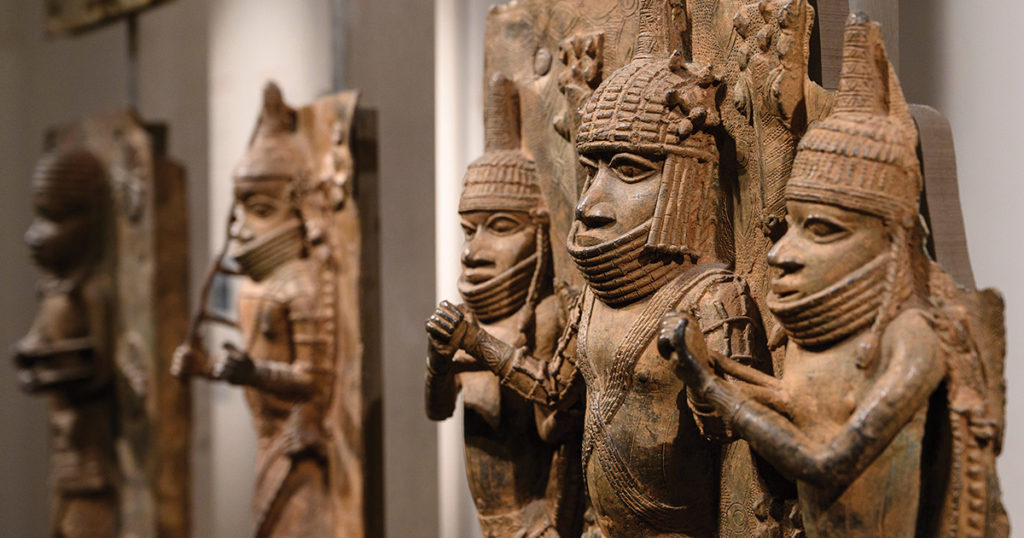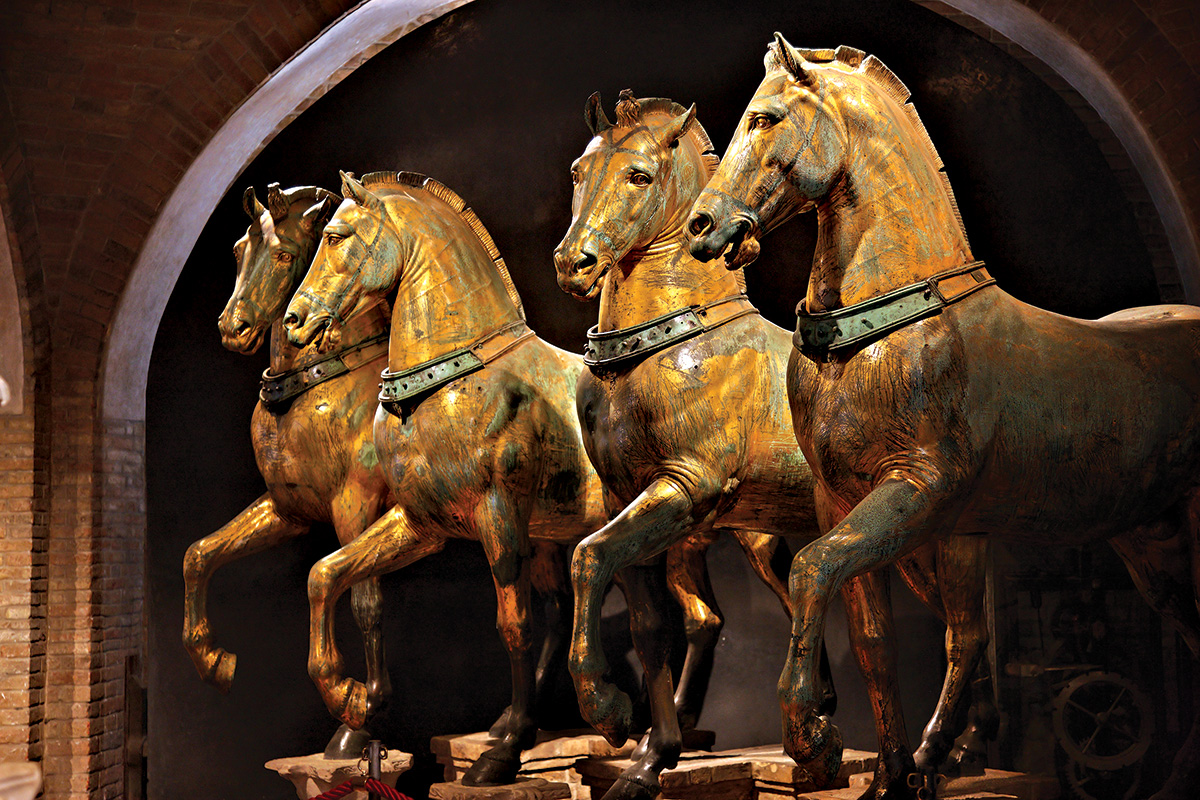The Inheritance of Nations
To what extent does a work of art belong to the people of the world?

Napoleon had two armies: one for conquering nations, the other for gathering their artifacts. At its height, the Grande Armée numbered nearly 700,000—infantry, cavalry, and artillery capable of military dominance across the European continent. On its heels, legions of antiquarians and scholars systematically captured the cultural treasures of subjugated states. It was the success of this second army that made Napoleon’s France the greatest European empire since Rome. The Horses of St. Mark’s Basilica in Venice, the Vatican’s Apollo Belvedere, the Egyptian sarcophagus of Nectanebo II, the Rosetta Stone—all were packed onto ships and sent to the Louvre.
Napoleon’s dual armies make a great deal more sense if we accept two principles put forth by the art historian Albert Elsen: first, that art can tell people who they are and where they came from; and second, that great art possesses a kind of autonomous spirit, belonging to a nation, not an individual. Can conquest of a nation be complete without the conquest of its great art?
The military dominion of Napoleon did not last, and his surrender at Waterloo marked the apparent end of French cultural hegemony. Scattered states and nations clamored for the return of their great art and artifacts—what we now might call their cultural patrimony. The Duke of Wellington, who led the British to victory at Waterloo, bolstered the repatriation claims of Italian states. He argued that the claims to possession “by the French government [were] founded upon the silence of the Treaty of Paris of May, 1814,” which had ended that part of the war. Against the claims of other European nations, silence, it seems, was not enough for France to keep its acquired treasure. With the political and economic help of the British, the Apollo Belvedere was returned to Rome, and the Horses went back to St. Mark’s in Venice. These repatriations fueled the great interest in European public museums, launching museum-funded archaeological expeditions.
The repatriations did not deter the imperialist capture of culture. In 1816, only a year after the end of the Napoleonic Wars, Thomas Bruce, the Seventh Earl of Elgin, sold a series of marbles from the Parthenon to the British government. Lord Byron excoriated the action as theft:
’Tis Greece—but living Greece no more!
So coldly sweet, so deadly fair,
We start—for soul is wanting there.
They were acquired, Elgin replied, from the Ottoman government via written decree. (The law tells us even souls can be sold through contracts, he implied.)
Last November—128 years after France sacked the Kingdom of Dahomey—343 French senators unanimously approved a bill to return 27 colonial-era objects to Benin and Senegal. It marks the first major step toward achieving the recommendations laid out in the 2018 government-commissioned Sarr-Savoy report on French-African cultural relations. According to the report, repatriation would help to “give back to them an impeded or blocked memory.” In other words, it would help return a little bit of the “soul” stolen from Benin in 1892; it would help return Benin’s cultural patrimony.
In a kind of response to the proliferation of restitutions following Waterloo, current French law considers all public collections in the country “inalienable.” That is, nationally owned art cannot legally be removed from France for any reason. Over concerns about the broader implications of repatriation, the French senate took care to characterize the recent bill as having a “strictly exceptional, ad hoc and limited character.” The minister of culture, Roselyne Bachelot, added that this “is not an act of repentance, but an act of friendship and trust.” (France has no intention of giving up other items taken from other nations, she implied.)
Britain and other European colonial powers have been slower to respond to calls for repatriation. Hartmut Dorgerloh, the director of the Humboldt Forum in Berlin, questioned the extent of this mission in a New York Times article from November 2018: “How far back will you go? Until Roman times? Because many items in Rome were robbed somewhere in Greece or in ancient Egypt.”
Dorgerloh’s question may have been rhetorical, but it is worth some consideration. The first definition given for patrimony in the Oxford English Dictionary is: “The estate or property belonging by ancient right to an institution, corporation, class, etc.; esp. the ancient estate or endowment of a church or religious body.” In the second definition we find the connection with its Latin root, patria: “Property inherited from one’s father or passed down from one’s ancestors; an inheritance.” (Property, naturally, was owned by men and passed down to sons.)
Looking to American law, we find only one definition for cultural patrimony, in the Native American Graves Protection and Repatriation Act, which defines it as
an object having ongoing historical, traditional, or cultural importance central to the Native American group or culture itself, rather than property owned by an individual Native American, and which, therefore, cannot be alienated, appropriated, or conveyed by any individual regardless of whether or not the individual is a member of the Indian tribe.
It is estimated that more than 90 percent of Native American archaeological sites have been destroyed or looted. Perhaps this explains why, in the entirety of American law, cultural patrimony appears only here, only in regard to indigenous cultures. To remove such cultural patrimony from a tribe is to remove an understanding of where a people came from, as well as the soul of who they currently are.
The British, who popularized the Grand Tour in the 18th century, wished to connect their then-current culture to that of antiquity. To strengthen a thin and fraying thread between the crumbling ruins of Hadrian’s Wall, 73 miles of stone in northern Britain that marked the frontier of the Roman Empire, and the Roman baths, or thermae, in the city of Bath in the west of England, British architects chose to build in the neoclassical style, reinserting themselves into the lineage of the Roman style—itself an inheritance of Etruscan and Greek styles. Does this make classical patrimony now part of the British patria? Whose wall is Hadrian’s?
The philosopher Kwame Anthony Appiah asserts that a universalist understanding (popularized by legal theorist John Merryman) makes plain that the value of cultural property is to people and not to peoples. It isn’t peoples, he says, who experience and value art. It’s individuals. And individuals deserve to see a diversity of art wherever they are; European art should adorn African museums, and African art should grace the walls of South American galleries.
The idea that “each people makes its contribution to the culture of the world,” codified in the Hague Convention of 1954, has proved particularly compelling for international legal regimes. UNESCO classifies, monitors, and—in rare circumstances—protects World Heritage Sites (like Hadrian’s Wall) around the globe. This idea of universality is also the animating principle of the modern museum. On its website, the Metropolitan Museum of Art defines its mission like this: “The Metropolitan Museum of Art collects, studies, conserves, and presents significant works of art across all times and cultures in order to connect people to creativity, knowledge, and ideas.”
As a first-generation American of Brazilian parents, themselves the grandchildren of Italian immigrants, I have no fatherland; I have no inheritance locked up behind museum glass. If I can lay claim to a culture, it is the “cultural heritage of all mankind” invoked by the preamble of the Hague Convention.
Can I, as a thinly connected descendant of Italians, see myself in a Roman sculpture?
The notion of a particular “origination” is remarkably elastic; few cultures have such a clear beginning in time and place as that of indigenous tribes. Among the objects the Italian government has demanded back from American museums in the past few years are ancient Athenian vases and Etruscan candelabra. Former Italian Minister of Culture Rocco Buttiglione has spoken of such efforts as a way “to give back to the Italian people what belongs to our culture, to our tradition and what stands within the rights of the Italian people.” Surely the Etruscans and the ancient Greeks would balk at seeing their culture so fully sublimated into the Roman tradition. To quote Appiah, “patrimony, here, equals imperialism plus time.”
And who owns the inheritance of nations that no longer exist?
The Horses of St. Mark’s first arrived in Venice decapitated. They had been taken from the Hippodrome in Constantinople around 1200, after the Fourth Crusade, and likely date to the second or third century A.D. As far as I can tell, Turkey has not laid claim to the Horses, despite evidence that the quadriga (the horse-drawn chariot) was in place when Constantine founded the city in 330 A.D. The Turkish, it seems, do not consider the sculptures to be part of their cultural patrimony. And yet, 600 years and multiple wars later, the Venetians certainly do.
Here, perhaps, etymology provides some clarity : Patrimony: Of multiple origins. Partly a borrowing from French. Partly a borrowing from Latin. Etymons: French patrimoine; Latin patrimōnium. Like language, modern states are necessarily of multiple origins. Turkey is the inheritor of many forebears—not just the Ottomans, but also the Byzantines, the Romans, the Assyrians, and more.
Inheritance is an active endeavor. On a mundane legal level, patrimony is the work of contract. Fathers pass on property to sons who choose whether to pass on that property to their sons. States—patrias—actively assert certain cultural narratives while discarding others.

The Horses of St. Mark’s Basilica in Venice—looted by the Venetians in Constantinople c. 1200 and later seized by France (Hercules Milas/Alamy)
Recognizing cultural patrimony as active rather than passive opens the possibility of ownership to something beyond constructed national borders but less than a global free-for-all. Colonialism does not automatically transform into universalism in the 21st century, but neither can looted art be returned to a precolonial state that no longer exists.
At the end of last year, the Ghanaian-British architect David Adjaye revealed his plans for the Edo Museum of West African Art—presumably where Benin will house the 27 repatriated artifacts from the vanquished Kingdom of Dahomey. “You need the objects,” Adjaye told The New York Times, “because the objects provide the provenance and the physicality that start to connect you.” But the objects alone do not reconstruct culture. According to Adjaye, a process of relearning “the fundamental meaning of these objects” must occur. For heritage to become patrimony requires a cultural infrastructure “that will be part of the community’s daily rituals and lives,” a museum that will actively connect the present patria to the inheritance of the past.
France is right to return the 27 artifacts to Benin, and Britain would be right to return to Nigeria the Benin Bronzes—more than a thousand extraordinary sculptures and plaques—it took in 1897. (Ireland and Germany announced this year that Benin Bronzes in their museums’ collections would be returned.) Perhaps, then, with no claims from Turkey, the Horses of St. Mark’s also belong in Venice, even if they came from farther eastward. An active heir is a rightful heir.
This is a less-than-clear-cut resolution, but that is to be expected. Culture is an elastic concept. As nations shift, so do their souls.
To quote the Welsh Imagist poet and attorney Allen Upward, “If Britain gives birth to Byrons, she also gives birth to Elgins; and as a rule the Byrons are usually in exile, and the Elgins are in office.” After the end of the Napoleonic Wars, the sarcophagus of Nectanebo II and the Rosetta Stone found their way to the British Museum, where they remain, if my memory serves, not all that far from the Parthenon marbles. Elgin’s alleged decree from the Ottomans, the one he said gave him the right to those marbles, remains, still, undiscovered.

